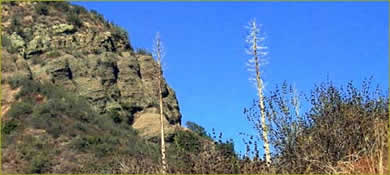Tucker Still a Sanctuary
Fires Almost Overwhelm Tucker Wildlife Sanctuary Before It Was Saved
October 29, 2007
By Russ Hudson
Marcella Gilchrist, on-site director of Cal State Fullerton's Tucker Wildlife Sanctuary in Modjeska Canyon, got the official word late Thursday night: She has a home to go back to. Then she was allowed two very short visits over the weekend and saw just how close she came to looking for somewhere else to live.
Saturday, Gilchrist e-mailed the university (parentheses added):
“Ford donated six trucks so the fire department could ferry people
to see their homes for 10 minutes. I went in last night and again this
morning. The buildings are okay; the animals are hanging in there. I
did get them all fed. I turned the water on in the (turtle) pond and
left it running for wildlife. The main grounds are untouched, (but) they
had to set a backfire behind (my) house so the hillside vegetation is
gone. The (fire in the Cleveland) National Forest burned to the (fire)
truck (access) road, including our chaparral trail. All in all, not bad.
-Marcella”
The arson-caused Santiago fire, driven by relentless high winds, ravaged its way up to the historic Modjeska House near the sanctuary, where firefighters managed to halt the fire and save the old structure. Then flames tore through the brush and trees on the other side of the narrow canyon to the crest of a rocky escarpment overlooking the sanctuary, where firefighters, who had already been fighting fires for days, took another stand and drove the flames back there, too.
Gilchrist began firefighting before the flames got close to the sanctuary.
“As soon as we saw the smoke after the (Santiago) fire started, we — the people who live in Modjeska Canyon, we’re a pretty tight-knit group — started getting ready. I put sprinklers up on the roofs of the buildings at Tucker, including my house, and left them there for 24 hours or so. The roofs, the walls, the areas around the structures were pretty saturated.

“Many of the Modjeska Canyon residents recently completed eight weeks of fire education and training by the fire department. Brush and debris had been cleared from around homes,” said Gilchrist. “Some dead trees, including at Tucker, had been removed and many residents had bought $500 (fire retardant) foaming kits and registered them with the fire department. We left and, as the firefighters withdrew from the canyon themselves, they foamed the houses.”
Gilchrist said she got several offers of help from staff members at the College of Natural Sciences and Mathematics, which administers the sanctuary, and others if she needed to evacuate, but she couldn’t take advantage of them. Because of the powerful swirling winds, “When the time came that we really had to leave, it came so fast it was simply not worth risking anyone else’s life trying to get in there. At that point, I had to just do it myself, but I pretty much knew what had to be done. It wasn’t all by myself, really. Ed Green, the plumber who takes care of Tucker, voluntarily helped with moving and packing things. He was a real help.
“I collected Henry, our 68-year-old tortoise — I couldn’t leave him behind — Cracker, our new young opossum that we rescued when his mom was hit by a car, and we took our kitty, named Kitty. We also took the snakes we had in the museum,” she said.
“But,” Gilchrist added, “we had to leave the turtles in the pond. They’re wild; there was no way to catch them in the time we had. (I figured that) as long as the water didn’t get too hot, they would be OK anyway.”
She found friends who would take care of the animals until they could be returned to Tucker … or until they needed a new home. And, like her animals, she found a friend to stay with until she knew what came next.
Gilchrist, who was raised around ranch animals and wildlife, and whose bachelor’s (’04) and master’s (’06) degrees in geology from Cal State Fullerton emphasized environmental analysis and environmental education, has an affinity for animals, and their fate concerned her.
“I hope the wildlife will get through this, but it will be hard. Animals like mule deer will probably be able to save themselves, but the mid-size animals, like bobcats and skunks and coyotes, are loathe to move. Birds are, too — they’re territorial. After a fire, there are always a lot of singed and injured birds. The ones who will have the easiest time are the burrowers, like spiders and gophers. Only the top few inches of the ground heat up, so they just go down and wait until it cools. The problem is when they come up there won’t be anything to eat.”
Gilchrist did one more thing before leaving. She left behind a satellite telephone. Cell phones don’t receive signals in Modjeska Canyon, so the sanctuary was supplied with a satellite phone to use if the landlines went down. “The people in the canyon know there is a satellite phone there,” she said. “I left it so they could use it if anyone got trapped. I also left out shovels, hoes and things if they needed those.”
Gilchrist said she when she is allowed to return to Tucker, it won’t all be back to normal. With the huge impact of the fires, many have forgotten that before the flames there was wind, and the story in the news then was about the wind damage. Tucker did not avoid that. In fact, it had closed in the days before the fire to deal with the winds.
“There are trees across the road, across the trails, all kinds of things to take care of as soon as I’m back,” Gilchrist said. “That’s going to be a lot of work. I’m hoping to get help from Eagle Scouts or someone. But it’s still standing. That’s what counts.”


